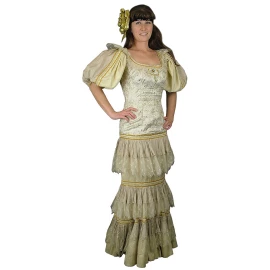Dress Art Nouveau
Filter products
Dress Art Nouveau
Art Nouveau Fashion in the 1890s in European and European-influenced countries is characterized by long elegant lines, tall collars, and the rise of sportswear. Fashionable women's clothing styles shed some of the extravagances of previous decades (so that skirts were neither crinolined as in the 1850s, nor protrudingly bustled in back as in the late 1860s and mid-1880s, nor tight as in the late 1870s), but corseting continued unmitigated, or even slightly increased in severity. Early 1890s dresses consisted of a tight bodice with the skirt gathered at the waist and falling more naturally over the hips and undergarments than in previous years. The mid 1890s introduced leg o'mutton sleeves, which grew in size each year until they disappeared in about 1906. During the same period of the mid '90s, skirts took on an A-line silhouette that was almost bell-like. The late 1890s returned to the tighter sleeves often with small puffs or ruffles capping the shoulder but fitted to the wrist. Skirts took on a trumpet shape, fitting more closely over the hip and flaring just above the knee. Corsets in the 1890s helped define the hourglass figure as immortalized by artist Charles Dana Gibson. In the very late 1890s the corset elongated, giving the women a slight S-curve silhouette that would be popular well into the Edwardian era.


